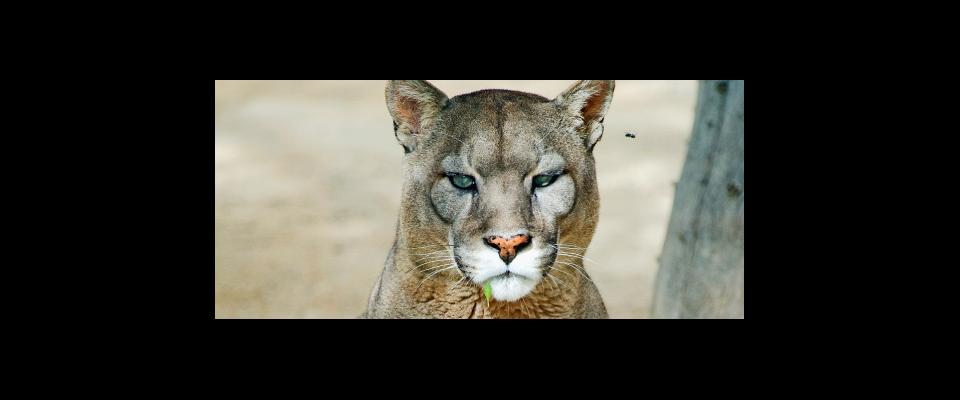Is California’s elusive puma moving into the urban jungle?
Around 2 a.m. on Tuesday, August 31, Berkeley police were alerted to a surprise visitor, a young mountain lion roaming the streets behind the famous Chez Panisse restaurant. An agile jumper (pumas can leap as high as 18 feet and as far as 40 feet), the cat fled over fences and through parking lots and backyards until, an hour and a half later, the police killed it with a shotgun. On local blogs and news sites later that morning, community members expressed their approval, anger, or confusion as they considered the question: Did the police do the right thing?
Yes, says Cal wildlife conservationist Reginald Barrett, Ph.D. ’71, who specializes in the urban-wildland interface and has conducted several studies on cougars statewide. That lion was typical of the six or so animals that have wandered into Bay Area cities in the last decade—a 2-year-old healthy male that probably came down from Tilden Regional Park. Left alone, the puma might have found its way back to the park. But it could just have likely ventured farther into the city, where it might have attacked someone or been harassed by dogs or hit by a car—this last being one of the leading causes of cougar mortality, according to Barrett.
Although tranquilizing and relocating these occasional urban visitors is an option, sedation requires training to nail down the right dosage—too much could kill the animal; too little and it could wake up prematurely. Furthermore, relocating the creature, according to Barrett, doesn’t solve the problem that’s driving these juveniles into city centers: a lack of space. “There’s no place that you can put lions that there aren’t already lions,” he says.
Decades of shooting on sight and bounty hunting nearly drove the state’s mountain lions extinct in the first half of the last century. In the early 1960s, the bounty was discontinued but licensed hunting was still allowed despite the 1972 moratorium on all sport hunting licenses. Since the passage of the Wildlife Protection Act in 1990, killing the animals is allowed only with a depredation permit, which is given to residents who can prove a lion has threatened their livestock or property. The California Department of Fish and Game puts the total population at somewhere around 5,000 cats, and Barrett speculates there are now lions in areas where historically they may have been absent.
Mountain lions, also called shadow or ghost cats because they are known for being elusive, are territorial and require huge home ranges. A mature dominant male typically roams 100 square miles. A female will produce anywhere from one to four kittens a year. At about 1 or 2 years of age, the offspring strike out to establish their own territory. It’s usually at this stage that the animals find their way within city limits. Relocating a young lion into a territory where a mature male lives could lead to the youngster’s death in a territorial battle or could force the animal to wander once again right into city limits, said Barrett.
There is a more troubling scenario, according to journalist David Baron, who documented the escalation of cougar attacks on humans in his hometown of Boulder, Colorado, for his book Beast in the Garden. Residents of Boulder and Berkeley may be similar in their desire to live close to nature and their welcoming attitude toward wildlife—a dangerous combination, according to Baron. People who live near deer and either feed them or have gardens that attract them, and people who leave their pets outside unsecured in cougar country are kidding themselves when they say, “‘I’m leaving the mountain lions alone,'” warns Baron, “because the signal you are sending these lions is ‘come on in.’ I mean, from a lion’s point of view, why wouldn’t it come down into Berkeley?”
“We’re responsible for that lion that came in, and maybe we need to do things to remind them that they’re not welcome in town. It’s not good for them, and it’s not good for us.” He cites an attitude change in Boulder that began in 1991, when a student was killed and eaten by a cougar. Now residents take care to lion-proof their dog runs and their hobby animal enclosures, and use noisemakers, rubber bullets, and other harmless methods to chase off cougars that come within city limits.
Baron is also quick to put the danger into perspective. Even in cougar country, the chances of being killed in a lion attack are slim—more people die annually from domestic dog attacks or rattlesnake bites.
Nevertheless, human-cougar encounters have risen in California this last decade, according to Steve Bobzien, ecological services coordinator for the East Bay Regional Park District. He estimates there are about 20 sightings a year in the parks he oversees. Bobzien suspects many more sightings go unreported, so it’s unknown how many lions live in the hills, or the status of their population. And here lies another dilemma: Though cougars may be doing fine statewide, they have become locally extinct in key areas, particularly in rapidly urbanizing areas.
In this critical period of change, a group called the Bay Area Puma Project is spearheading research that will help provide some insight into these creatures. For the last year, researcher Chris Wilmers, Ph.D. ’04, and his lab at UC Santa Cruz have been tracking cougars in the Santa Cruz Mountains. To date, 17 cats have been collared with equipment that records where they go, how fast they’re moving, and at what angle they’re holding their heads at a particular moment. The researchers are gathering similar information on speed and angular motion from captive pumas moving in a controlled laboratory setting. By comparing the two data sets, they can determine the wild cougars’ behavior at various points in time. The study will help answer some key questions: how these cats react to humans; how they may behave differently in urban areas; and how they navigate the fragmented natural areas indicative of the urban-wildlife interface. Zara McDonald, MBA ’97, the founder of BAPP and its parent organization, Felidae Conservation Fund, hopes to start studying the East Bay puma population in a few years’ time.
For Reginald Barrett, a resident of Orinda, a cougar sighting is awe inspiring, and he is reluctant to see the animals killed even though he understands that sometimes it’s the best thing to do. “They’re neat animals, and I hope we can continue to have them in California, but we’re going to have to come to a better understanding amongst the general public about how the real world works, you know. It really doesn’t work like Disney movies.”



















